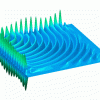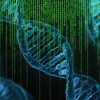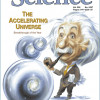Science News
Solved at Last: A Fundamental Problem of Quantum Physics
For over half a century, theorists have tried and failed to provide a complete solution to scattering in a quantum system of three charged particles, one of the most fundamental phenomena in atomic physics. Such interactions are everywhere; ionization by electron impact, for example, is responsible for the glow of fluorescent lights and for the ion beams that engrave silicon chips. Read More »
BOOMERanG Analysis Finds Flat Universe
Newly released data from the 1997 North American test flight of BOOMERanG, which mapped anisotropies in the cosmic microwave background radiation (CMB) in a narrow strip of sky, show a pronounced peak in the CMB "power spectrum" at an angular scale of about one degree, strong evidence that the universe is flat. Analyzed at the Department of Energy's National Energy Research Scientific Computing Center (NERSC) at Lawrence Berkeley National Laboratory, the new… Read More »
New Biological Database Seeks Out Products of Alternative Gene Splicing
In its first half year of operation, a new database that identifies clusters of proteins arising from alternative gene splicing has received more than 35,000 requests from researchers in genetics and cell and developmental biology around the world. Read More »
NERSC and the Fate of the Universe
When the National Energy Research Scientific Computing Center (NERSC) moved to Berkeley Lab in 1996, a computational science program was created to encourage collaborations between physical and computer scientists. The Supernova Cosmology Project's work was one of the first projects funded; it demonstrates how high-performance computing can accelerate scientific discovery. Read More »










